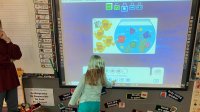Using Digital Escape Rooms to Make Learning Fun
Students as young as preschool are able to solve engaging learning puzzles, and teachers can use these resources to design their own.
Your content has been saved!
Go to My Saved Content.When you think of escape rooms, you probably imagine adults trying to solve a puzzle in a short amount of time. Did you know that children as young as 3 can participate in them as well, and will be begging to play again?
In escape rooms designed for young children, students are actively engaged with their whole class, with their teacher, or in small groups working to solve puzzles. Once they solve a puzzle, students have to work together to open a lock in order to “escape” from the room. When students manage to open the lock, you can hear the excitement across the room. Here are some ideas to bring escape rooms to pre-K through third-grade classrooms.
How Do Escape Rooms Work?
Teachers can integrate any subject area into an escape room game. The purpose of the game is for students to think outside of the box, critically analyze the puzzles, and come up with ideas and solutions without their teacher instructing them where to look or what to read. Games can take as little as five minutes for a single lock of the day or up to 45 minutes for more complicated escape rooms.
For prekindergarten and kindergarten students, puzzles can ask students to complete tasks such as providing beginning letter sounds to pictures, using a UV flashlight to uncover hidden numbers, or putting objects in order by a specific attribute. For students who are not yet reading, some digital clues may have the option of text to speech or a recording of the text for students to listen to.
For students in older grades, the puzzles can involve having them solve mathematical equations, put words in alphabetical order, read and analyze a graph, or use a cipher to decode a word.
Helping Students Succeed in Escape Rooms
Once students have solved a puzzle, they use that answer to try to open a lock. If they’re right, the lock opens and they escape. If not, they go back to the puzzle. This is a great time to model using teamwork, taking turns, listening to one another’s ideas, and never giving up. These tips can help teachers guide students to success in breakout rooms.
Model, model, model—without giving answers: Our youngest learners need us to model routines repeatedly. This will help your game time run more smoothly, but beware of your students asking you for the answers. Step back and give them encouragement. You can let them know they have the resources in front of them and in their brains. Together as a team, they can come up with some ideas.
Debrief and reflect when the game ends: When time runs out, did they break out? Even if students were successful in breaking out, debriefing and reflecting on the process is vital for the next time you play with your students. Where could we improve? What was difficult? What was easy? What can we try the next time we play?
Increase difficulty throughout the year: The first time through, teachers should work through clues and puzzles together as a class. If I start with one puzzle box for the class in the fall, by December, I have two or more boxes that I put together for students to play. When students have really boosted their teamwork and collaboration skills, I have small groups of three to four students working on one box or digital game at a time. This allows students to brainstorm ideas and solutions to the puzzles and really race against the clock.
Where to Find Escape Rooms
Breakout EDU and Google Sites are two resources for finding escape rooms, and teachers can also build their own.
Breakout EDU: One option for acquiring escape rooms is Breakout EDU, a platform full of standards-aligned games. Teachers can choose either digital games to play on the TV or interactive board or kit-based games that come as a box students can work through. The Breakout EDU platform holds hundreds of games that are ready to prepare or share with your students and that integrate directly with content standards and team-building skills. Breakout EDU kits also contain reflection cards or questions that are perfect for debrief time, as well as extension ideas if your students became “Lock Stars” by breaking out of the room. You can find details about pricing and options on their website.
Google Sites: Digital escape rooms embed an intriguing story into a Google Site. The Google Site contains puzzles based on the story which students must solve. They enter their answers into a Google Form containing a series of digital locks. Once they have unlocked the digital locks, they have escaped. Students love working together with their peers to solve these digital escape room games. The story and puzzles pique their interest, especially when they have to race against the clock.
Make your own: Teachers can make their own escape rooms as well. If you are creating your own, decide what content standards or themes you want to focus on with the escape room. Create a Google Site, and come up with an intriguing story that will grab your students’ attention. Make a copy of this digital escape room Google Form, created by Tom Mullaney, and create your own puzzles.
After you’ve published your game, you can share it to your learning management system or create a QR code so students can access and play. Watch as students begin to immerse themselves in games and their communication, collaboration, and problem-solving skills grow.
